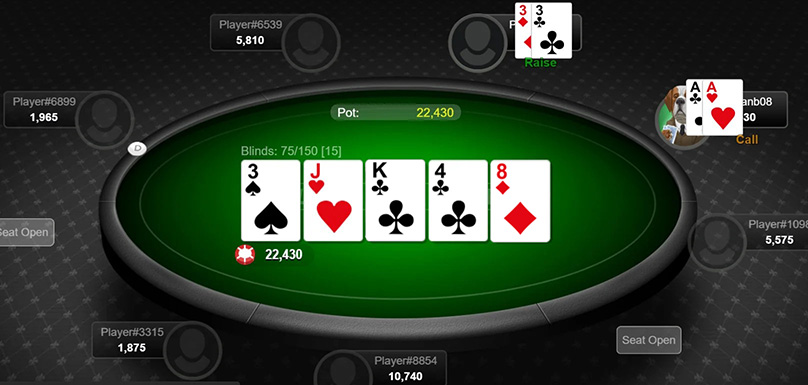Using stats in online poker used to be considered one of the most important elements of a good poker strategy, as professional players relied heavily on stats for many years.
This has changed more recently, as most top pros now try to play some version of a GTO poker strategy and beat their opponents by consistently playing a well-balanced and unexploitable strategy.
Yet, poker stats remain important even in 2024, with VPIP being the most basic of all the stats and perhaps the easiest to take advantage of.
In this article, we are going to explain what VPIP is in poker, how it can help you identify weak players, and how you can exploit this poker stat to increase your profits at the poker tables.
What Is VPIP in Poker?
VPIP stands for “voluntarily put in the pot,” and it refers to the money or chips a player puts into the pot before the flop without being forced to. This means forced bets like blinds and antes don’t count towards VPIP.
Anytime a player puts money into the pot without being forced to, whether it is by calling, betting, or raising, your poker tracking program will pick it up, and their VPIP stat will go up slightly.

The higher a player’s VPIP number, the more active they are overall and the more hands they enter before the flop.
While VPIP alone does not tell you everything you need to know about the player’s overall poker strategy, it can tell you whether they are playing too many or too few hands overall, and in combination with other stats like PFR and WTSD it can tell you plenty about their tendencies as well.
Before we look at how these stats can be used jointly to figure out how your opponents play, let’s first examine what the stat means on its own and what optimal VPIP numbers should be.
Looking at VPIP in Isolation
The VPIP stat becomes extremely useful when observed in combination with other stats, but even the number alone can tell you quite a bit about your opponents.
The one thing you can read straight from a player’s VPIP stat is how many hands they play on average. The VPIP number directly reflects the percentage of hands a player plays. So, a 25 VPIP means that the player enters 25% of all pots in one way or another. From this, you can begin to construct possible poker ranges they are playing.
Here is a quick look at what different VPIP numbers can mean:
- 1 – 10 VPIP: Extremely Tight
- 11 – 20 VPIP: Tight
- 21 – 30 VPIP: Loose
- 31 – 40 VPIP: Very Loose
- 41+ VPIP: Extremely Loose
Before you give the VPIP number too much significance, make sure that you have collected information over at least a few dozen hands and preferably across a few hundred.
If you rely too much on stats gatherer over 10 hands, you might end up paying back at a player who simply got dealt 10 very bad hands in a row, which happens all the time.
Once you are sure your stats correctly reflect a player’s tendencies, you can start making some conclusions based on a player’s VPIP number.
Solid players will usually have a VPIP in the region of 25, as they will be playing looser than the nits but tighter than the recreational players and fish out there.
Anyone showing a VPIP that is significantly higher or lower than that will be your target, and you should be looking for ways to exploit their tendencies.
Exploiting Players with a Low VPIP
Players with a very low VPIP stat in poker tend to be the tightest of them all. Generally speaking, these are the nits of the poker world who only play when their cards are very good.
Against these types of players, you will definitely want to be very careful, although, for the most part, you will be able to stay out of their way and fold when they enter the pot.
A player with a VPIP of 15 or under coming into the pot for a raise should immediately raise the alarms in your head, as you should know that this player has an extremely powerful hand, to begin with.
Against these player types, you can use the strategy of trying to make big hands on the flop, as they will typically have strong holdings that are hard to get away from after the flop.
For instance, if you hold 33 and call a nit’s raise, you will very often win their entire stack when you make your set.
However, when a nit enters the pot for a limp, which will often be the case, you will have every chance to pounce on that limp, as their range will be much stronger.

Keep in mind that nits will often also limp their strongest hands and come back over the top of your raise with them, so don’t fall into this trap. If a nit limps and then 3-bets you, throw your JJ into the muck and wait for a better situation.
Exploiting Players with a High VPIP
There are different types of players with a high VPIP stat, and you will definitely want to play quite a bit differently against them.
A high VPIP can mean a calling station who limps into a lot of pots, calls a lot of preflop raises and rarely raises himself while often playing his hands all the way to showdown.
On the other hand, a high VPIP can also mean a maniac who raises and re-raises any chance he gets, leading to a VPIP stat of 40 or higher.
In order to determine which player type you are playing against, you should take a look at their PFR stat and their WTSD stat along with their VPIP, as this will tell you more about their raising and calling tendencies.
Playing against calling stations, you will want to base your game heavily on value hands, looking to stack them whenever you get a top pair or better, as they are very likely to go a very long way with a mediocre hand.
Against maniacs, on the other hand, you will need to play a more volatile style of poker. When a maniac re-raises you, and you have pocket Nines, it will often be time to ship it all-in and watch the maniac fold his bluff or stack off with some nonsense like 87s.
Of course, these are all generalizations, and you will not want to play every poker hand at every stack depth the same way against a player type, but using VPIP to help you determine how your opponents play will be a good stepping stone in formulating a winning strategy against them.
Recognizing the Fish with VPIP
While the VPIP stat can be used to recognize all kinds of subtle exploits in different player types, the biggest advantage the stat will give you is the ability to recognize fish in your games very fast, especially if you are playing multiple tables.

Since you can’t quite observe everything that is happening on a dozen tables, you might often miss a player limping into pots that you have folded out of, which is where VPIP and PFR stats will come in handy.
What you will be looking for is players with a high VPIP stat and a low PFR stat, as this combo indicates the absolute weakest poker players out there.
A player playing a VPIP of 40 and a PFR of 12 is your preferred customer at any poker table, as it is the easiest type of player to play against.
This player plays 40% of all hands but only raises 12% of the time, which usually means they only raise when they have a very strong hand but limp along with another 28% of their range.
You can isolate this player’s limps relentlessly, as they are likely to have those medium-strength hands when they limp into pots, while you can easily fold to their raises with everything but the strongest hands and good speculative hands like pocket pairs.
These player types typically won’t battle deep into the streets either and will usually give up on the flop if they don’t connect or on the turn if their flopped draw doesn’t instantly get there.
Using VPIP poker stat to quickly recognize fish in your games is one of the most useful applications of this stat, although it is certainly not the only one.
Recognizing Strong Players with VPIP
Just as easily as you can recognize the fish in your games by looking at their VPIP number, you can also quickly figure out who the strongest players in the game are.
Good regulars these days typically play a VPIP of around 25 and a PFR of around 18, although this can change depending on the game format.
In either case, the difference between the VPIP and PFR of good players will not be as massive as that of the fish, and neither number will be extremely low or extremely high.
Since good poker players play a balanced strategy that includes both bluffs and value in their raising and 3-betting ranges, their PFR number will be significantly higher than the fish.
The discrepancy between PFR and VPIP comes from the times they call a raise in position or in the big blind, which they will often defend against small raises with a wide range of hands.
If you want to play a good overall strategy, your numbers should look like this as well, so you would be wise to make sure your VPIP does not go much lower or higher than 25 either.
Final Words on VPIP in Poker
The VPIP stat in poker is one of the most useful and commonly used by poker players who use poker tracking software, and one you should always include in your HUD.
Sites like GGPoker now even include basic poker stats like VPIP in their built-in HUDs, which means you will be able to track everyone’s VPIP even without having a third-party tracker installed in your device.
When looking to make those exploitative plays, make sure to take a player’s VPIP into account and think about the types of opening ranges, they could be playing based on their VPIP and PFR stats.
Just remember to only actually look at these stats once you have at least some sample of hands on a particular player, as you will need some repetitions before you can consider any poker stat actually significant.





